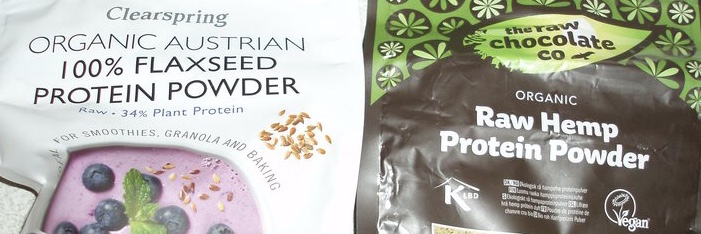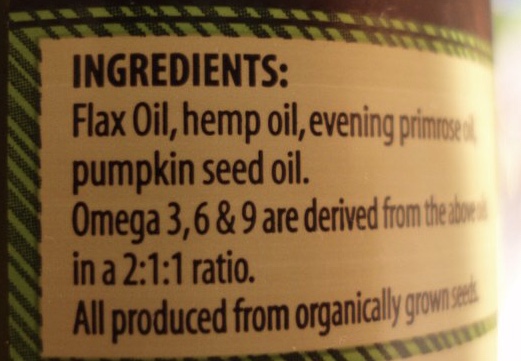Reading the product descriptions on my assorted packets, I noticed what seemed like complementary processes:
Protein powder: “The whole seeds are simply cold pressed then dried and finely ground” £5.89 350g 34% protein
Seed oil: “Made from the highest quality organic flaxseeds (linseeds) and cold pressed” £4.99 250ml 92% fat
This set me thinking why was I buying these separated products only to recombine them? All the extra work done, resources used, processing, packaging, extra faff, and probably extra cost for me, seemed nonsensical and wasteful. My ready cynicism flared up at another marketing monster. I read the product information more closely.
This protein powder talks about the benefits of the whole seed: “This organic hemp protein powder is made exclusively of hemp seed, which is one of the most concentrated, complete and balanced sources of Essential Amino Acids and Essential Fatty Acids available from the plant kingdom.
“Hemp Seeds are rich in essential nutrients including chlorophyll, phytosterols, ascorbic acid, beta-carotene, calcium, fibre, histidine, iron, potassium, phosphorus, magnesium, sulphur riboflavin, niacin and thiamine.
“Hemp Seed contains all 10 essential amino acids (EAAs). Hemp Seed Protein is comprised of 65% high quality Edestin Protein, the most potent protein of any plant source and highly compatible with the human digestive system.
“Hemp Seed is rich in Omega 6 essential fatty acids (EFAs) as well as being one of the few plant sources of GLAs. It also contains a large dietary supplement of omega-3 (higher than walnuts). These oils are known to improve memory and strengthen brain cells.” £5.86 250g 49% protein
This seed oil also contains pumpkin too, which I already eat whole: “a blend of flax, hemp, pumpkin seed oils, and oil of evening primrose” £6.49 250ml 90% fat
Why not just eat the seeds as they naturally come?
Flaxseed £5:15 425g 22.1% protein & 40% fat
Hemp seed £6.99 250g 30% protein & 41% fat
At the same time, after decades adhering to the low-fat doctrine, I finally gave myself permission to break that rule. Instead of struggling to keep the proportion of calories I get from fats below 33%, I focus on getting enough protein from vegan sources, and see what comes naturally along with that. Three clear results:
1. I don’t crave sugar between meals
2. I don’t feel bloated from eating huge amounts of grains and beans
3. I gradually lost some weight without trying.
Protein and fat give you satiety – they make you feel full. Carbs don’t, so you go on eating. Certainly decades of low fat advice hasn’t solved our societal obesity problem. I wonder if there is a counter-intuitive connection – maybe fat doesn’t make you fat?! Maybe it depends on your metabolism and dietary type. All I can say is the official advice didn’t work for me.
Now the proportion of calories I get from fat settles around 44%, protein 19% and carbs 37%, quite different from the ‘ideal’ 33–15–52. Everyone is different, of course, and with some verified nutritional information we should all figure out for ourselves what works best for our bodies.
Back with the seeds, I created a lovely wee spreadsheet to calculate the cost of my usual protein and fat intake from the two different routes – processed or wholefood. I like spreadsheets. I have the mug. What is interesting about the spreadsheetorama is that at my previous low fat level, buying protein powder separate from seed oils works out about 10% cheaper. However, eating fat at my current level and—crucially—at the natural level that comes in the seed along with the protein, it is now cheaper by about 20% to eat the seeds as they come.
I find it difficult to believe that the extra processing and packaging doesn’t add much to the cost. However, I’m aware that the whole hemp and flax seeds I’m eating are actually processed somewhat: eating hemp with the shells is like chewing through insect carapaces, which cut into your mouth, so I get it hulled.
Similarly, whole flaxseeds have a mucilaginous layer, like chia, so they just become immensely slippery and stick between your teeth rather than being ground down, and so you don’t digest them. Thus flax seeds are better ground and I can’t do it myself as efficiently as commercial processes, so I get it pre-milled and put up with having to refrigerate it. This also brings a time limit once opened of six weeks but I easily get through a pack in that time.
So, in this case, the Marketing Monster isn’t massively fleecing me for processing and packaging. Disappointing.

